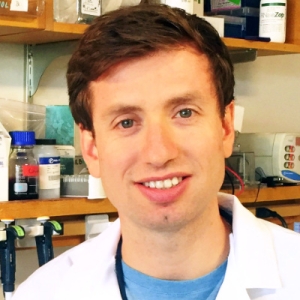New findings explore how cells fight viruses without harming themselves
Source: UCI School of Medicine

Graduate students Lavanya Manjunath and Gisselle Santiago with Rémi Buisson, PhD, from the UC Irvine School of Medicine’s Department of Biological Chemistry.
When your body gets hit by a flu virus, your immune system goes into attack mode. More specifically, double-stranded RNAs (dsRNAs), produced during viral infections, activate a response from an innate immune sensor known as PKR (protein kinase R). This triggers the shutoff of protein synthesis in the infected cells, as PKR effectively works to keep the virus from replicating and spreading. But what happens when PKR is unnecessarily triggered in healthy cells?
“PKR is a key antiviral protein that senses viral RNA once a virus enters the cell,” explains Rémi Buisson, PhD, an associate professor of biological chemistry in UC Irvine’s School of Medicine. “However, it is essential that PKR distinguishes viral RNA from the cell’s own RNA. When PKR is activated incorrectly due to the recognition of self-RNA, it can shut down the host cell protein synthesis machinery, causing an autoimmune response.”
Abnormal PKR activation in cells has been known to be associated with diseases such as Alzheimer’s, Parkinson’s, Huntington’s, ALS and myotonic dystrophy. “Given the harmful effects of uncontrolled PKR activation, cells must tightly regulate PKR to ensure that its activation occurs only in response to viral infections, not endogenous dsRNAs,” says Lavanya Manjunath, a graduate student in the Buisson Laboratory.
Manjunath, working with others in the Buisson Lab and the Semler Lab at UC Irvine, conducted a study to gain a better understanding of PKR defense mechanisms and how cells control their antiviral responses. The researchers outline their findings in a paper published in Nature Communications: “Cooperative role of PACT and ADAR1 in preventing aberrant PKR activation by self-derived double-stranded RNA.”
Understanding Immune Defenses
Using CRISPR-Cas9 screening technology, the researchers identified new factors that regulate the innate immune response to RNA viral infections. “We discovered that PACT plays a crucial role in preventing PKR from being activated by cellular RNA, ensuring that PKR is only triggered in the presence of viral RNA,” says Buisson. “This selective activation allows cells to mount an efficient antiviral response while avoiding unnecessary activation of immune pathways, thereby limiting viral replication and spread.”
PACT-deficient cells hyperactivate PKR in response to different types of RNA viruses. The study’s results also demonstrate that PACT cooperates with ADAR1 (adenosine deaminase acting on RNA 1) to suppress PKR hyperactivation from self-dsRNAs in uninfected cells. “The simultaneous deletion of PACT and ADAR1 results in synthetic lethality,” says Buisson. “We propose that both PACT and ADAR1 act as essential barriers against PKR, creating a threshold of tolerable levels to endogenous dsRNA in cells without activating PKR-mediated translation shutdown and cell death.”
Fighting Viruses and Immune Dysfunction
The goal is to identify new mechanisms that cells can use to block or prevent a virus from replicating, while also better understanding how to address the misregulation of immune responses, often associated with genetic diseases and immune dysfunction. Indeed, mutations in PACT lead to dystonia, a rare genetic neurological disorder characterized by involuntary muscle contractions.
“Our work reveals a cellular defense mechanism that is broadly applicable to a wide range of RNA viruses, including influenza virus, RSV, and SARS-CoV-2, some of the most common and pathogenic viruses infecting humans,” says Buisson. “It also addresses the fundamental question of how these defense mechanisms are precisely activated only in the presence of a virus, ensuring that uninfected, healthy cells are not harmed.”
This work was supported in part by funding from the National Institutes of Health (NIH). Other funders included the UC Irvine Division of Graduate Studies and the American Cancer Society.
